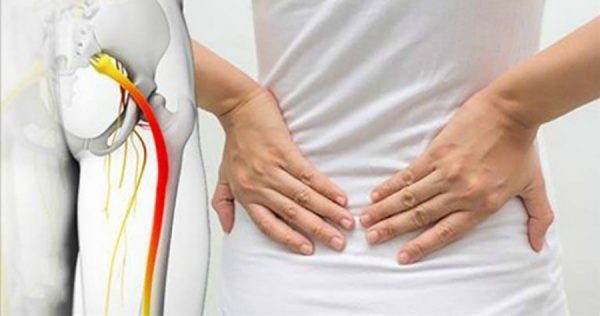The longest nerve in the human body is known as sciatic nerve. It actually starts at the base of the spine and runs down through the thigh to the foot. This nerve is responsible for providing strength, movement, and sensation to each leg.
Sciatica is a common health problem characterized by numbness, tingling, or pain from the lower back going down the leg. It typically affects only one side of the body. However, in some cases, it can affect both sides.
Here Are the Main Causes of Sciatica:
- Spinal Stenosis: It is a disorder characterized by nerve compression.
- Herniated Disc or Bulging Disc: It happens when a disc is damaged.
- Piriformis Syndrome: It occurs when the Piriformis muscles spasm and compress this nerve.
- Spinal Tumors: In some cases, a tumor can result in sciatic nerve compression.
- Spondylolisthesis: A bone in the spine slips out of position, either backwards or forwards, thus affecting the lumbar spine.
- Pelvic fracture or injury: If you fall or twist the pelvis while lifting, it can lead to sciatic pain.
- Trauma: It includes motorcycle or car accidents; or sports injuries.
Sciatica can be diagnosed through a physical as well as medical history. Your doctor may order the following medical tests: x-rays, MRI’s, or CT scans in order to detect the potential culprit of the health issue.
Sciatica Treatment Options
- Exercise
- Massage
- Chiropractic Care
- Topical Preparations
- Heat or Ice
- RF Therapy
- Physical Therapy
- Yoga
- Acupressure
- Acupuncture
- Pilates
- Pain Relievers
- Muscle Relaxants
- Surgery
Here Are 4 Effective Massage Techniques to Alleviate Sciatica
You can practice these self-massage techniques and stretches to relieve sciatica:
– Massage
Start by placing the palms on the lower back and then massage the pelvic area towards the spine and down towards the buttocks.
Afterwards, simply place the hands at the waist with the thumbs on the ropelike muscles. Make sure you wrap the fingers around the sides.
Use the thumbs to apply a steady and firm pressure toward the spine on the outer ropey muscle edges. Keep in mind that the thumbs should be 4 inches apart.
Try to put pressure without triggering discomfort.
– Knuckle Pressure
Start by lying on the back, bend the knees and place the feet flat on the floor.
You should make fists and place them on both sides of the lower back, so that the knuckles are against the back and the palms are facing down. Make sure it does not trigger discomfort.
Place the fists between the lower back and spine muscles. Try to stay in this position for about 60 seconds.
Gradually roll onto the side into a comfortable fetal position by placing the arm under the head. Stay in this position for about 5 minutes.
– Sciatica Stretches
Watch the video below to learn how to do some excellent stretches for sciatica relief:
– Massage with Tennis Balls
You can put pressure to the lower back with tennis balls.
First of all, place 2 balls close together in a sock or towel and then place it on the floor.
Next, you should sit down on the floor, bend the knees and place the feet flat on the floor. Make sure your place the tennis balls behind you.
Slowly lie on the back on the floor, so that the tennis balls are placed on the painful area of the back.
Rest for about 60 seconds.
When you feel relief, then place the balls to another area of the back.
Use the arm under the head to gradually roll onto the side into a fetal position. Try to hold for about 5 minutes.
Purchase This Equipment for Pain Relief
In case you suffer from leg, hip or back pain, you may want to buy the following items to help alleviate the pain and aches with acupressure:
- Tennis Balls
- Body Back Buddy – This item is an S-shaped tool that has knobs of different shapes and sizes for different pressure points on the body.
- Knobble – It can help you apply a more focused pressure to specific hip points.
- Spinal Roller – It is a hard tube covered with a thick foam. It can help alleviate hip pain.
- Kong Dog Toy: It is actually a wedge-shaped toy. The only thing you should do is place it under the hip, while lying on the side. It can elevate pressure as you roll on it.
Additional Tips:
Sciatica can limit your movement. Exercise can elevate blood flow, and supply your body with additional oxygen. It can warm up your muscles and alleviate pain.
However, in case you find this challenging, you should do some low impact exercises like water aerobics, yoga, or swimming. Also, consult your doctor prior to doing any of these exercises.
Source: theheartysoul.com

